“What about Chernobyl?” is a question many people ask whenever nuclear power is discussed. In my first look at that question, in the previous article, I put the World’s Deadliest Energy Accidents in Perspective. But many people will point out that direct human health effects are only a part of the story, and rightly so. What about the risk of making large swaths of land uninhabitable for humans or nature? This is probably the most iconic of our fears when it comes to nuclear accidents, and it also used to be my main concern with nuclear power. As I wrote in Nuclear Waste: Ideas vs Reality:
How could we justify producing any amount of energy if – bear with me – that meant risking that large areas of the earth become barren wastelands, should anything go wrong?
After all, although the deaths from Chernobyl number less than a hundred, eventually about 350,000 people had to leave their homes, as the surrounding areas were evacuated. The Chernobyl Exclusion Zone has a 30 km radius, covering about 2,600 square km (or 1,000 square miles), and it remains closed to normal human use after three decades. The psychological toll of so many people having to leave their homes – and its consequences on health – must also be weighed in the balance, as well as the lost land area itself. The sheer duration of radioactive contamination is a scary thought, the slow decay over hundreds, thousands, even hundreds of thousands of years.
So what kind of effects did the radioactive contamination have on the environment? And the follow-up question, which I look at in the next article: how do the effects compare to other energy accidents?
Chernobyl’s effects on plants and animals
What we know about effects of Chernobyl’s ionizing radiation on wildlife: an area of about 4-5 square kilometers of pine trees located 500 meters from the power plant were fatally hit, receiving a high dose of radiation from the accident. This area is among the highest contaminated still, and is known as the Red Forest, owing to the rust-red colouring of the dying trees.
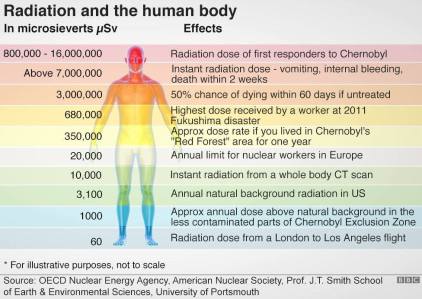
Perspective on radiation levels by BBC published earlier this year, including Red Forest as well as the less contaminated parts of the Chernobyl Exclusion Zone.
In a wider 38 square km area (comprising about 1.4% of the Exclusion Zone), trees largely produced no new seeds for 5 to 7 years. Soil invertebrates were drastically reduced within a 3 to 7 km radius from the plant, although their numbers had largely recovered after 2,5 years. There were likely deaths of mammals as well, as noted with the deaths of some horses and cows due to radiation damage to the thyroid tissue, and a decrease in rodent numbers which however returned to normal the next year.
While radioactive contamination from Chernobyl could be measured in areas as far as Germany and the Nordics, the actual levels of radioactivity were too low to lead to notable effects on wildlife elsewhere. The levels were observed and possible recommendations set for hunting or gathering in certain areas. And no, Bavarian mushrooms do not pose a health threat, despite what many Germans have been eager to tell me. German officials: “If wild game or wild growing mushrooms are consumed in usual amounts, the additional radiation exposure is comparatively low.” (In contrast, European authorities are more worried about heavy metals, PCB and dioxins in fish.)
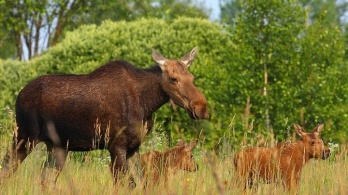
Life After Chernobyl – Savannah River Ecology Laboratory found the Chernobyl exclusion zone teeming with moose, roe deer, wild boar and wolves.
What about the larger animals in the Zone? Well, the science suggests that terrestrial wildlife are not likely to be harmed at levels below 1 mSv/day (translates to 365,000 microsieverts, ug, per year, when expressed as in the BBC graphic above, which would place just above the Red Forest level). A 2014 study on soil nematodes found no effects at 5 mSv/day, and several studies have found no effect on rodents even at 20 mSv/day (7300 mSv/year), or any differences in mammal populations in contaminated vs non-contaminated areas. The safe limits for plant and aquatic life, further, is suggested to be ten times as high as for terrestrial animals.
So the background levels themselves, although measurably higher than global average, and likely to remain so for a long time, may not be acutely threatening to wildlife. This might explain why a wide variety of animals quickly moved in to populate the zone after it was abandoned by humans. In a surprising turn, many rare and long absent species of wild animals have found themselves a home around Chernobyl.
The Chernobyl Exclusion Zone has arguably become a nature reserve
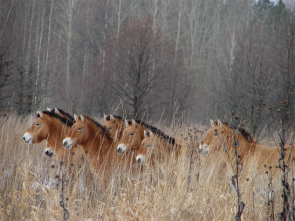
11 images show active wildlife at Chernobyl – Prezewalski horses.
^^ This was almost exactly the headline of a story run by BBC in 2016. They interviewed scientists who study the nature in the exclusion zone, which has an abundance of animal populations on par with nature conservation areas. The WHO also notes in Chernobyl: the true scale of the accident, that it paradoxically lead to creation of “a unique sanctuary for biodiversity.”
This development began rapidly after the accident, as reported by the BBC:
in large areas of the exclusion zone radiation levels dropped dramatically within months, says Jim Smith at the University of Portsmouth, UK. Wildlife began to bounce back, taking advantage of the absence of people.
Aerial surveys suggested that populations of elk, deer, and wild boar began climbing only a year or two after the accident. Projects with motion-activated camera traps begun in the nineties have yielded more information, BBC:
They found evidence of an extraordinary abundance of species. There were beavers, badgers, lynx and bison: even a brown bear made an appearance.

A 2019 study found highly diverse and active scavenger populations in the Zone, including mouses, jays, magpies, otter, raccoon dog, mink, wolf, raven, and white-tailed eagle.
A similar account by IBT, complete with many trap photos of wild animals, is titled: Wildlife in the Chernobyl Exclusion Zone: Bears, Wolves and Rare Horses Roam the Forests. There’s also a documentary about the Wolves of Chernobyl at PBS, or you can go view the material from camera traps at the TREE project.
European Radioecology Alliance describes the Zone as follows:
The area is species rich with more than 400 species of vertebrate animals, including 67 fish, 11 amphibians, 7 reptilians, 251 birds and 73 mammals; many being listed in Ukrainian and European Red Books.
That’s not to say that scientists would not expect to find any effects of radiation on the wildlife populations, but they are small enough for it to be difficult to find conclusive evidence. For a good discussion on the two scientists who claim to find effects on birds (like cataracts), and about the larger scientific community’s criticism of their claims and methods, see the earlier BBC article, or the 2016 paper Thirty years after the Chernobyl accident: What lessons have we learnt?.
It is clear that these potential effects do not, in any case, hinder formation of thriving animal populations. The striking conclusion is that the world’s worst nuclear disaster is much less destructive to wildlife populations than normal human activities. The habitat left empty after the nuclear disaster is a boon for wildlife. While evacuation is a very drastic and (for humans) disruptive way of creating space for a wildlife habitat, it is very hard to argue that biodiversity and animal populations in the area would be worse off thanks to the Chernobyl disaster.
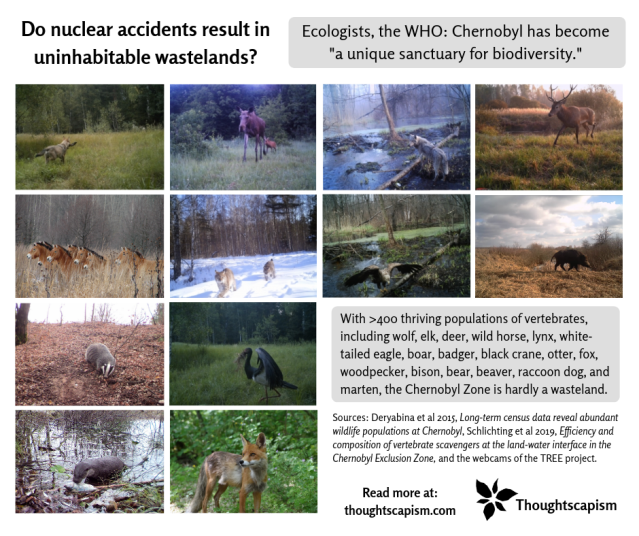
Sources: WHO overview about the true scale of the accident, 2015 paper on Long-term census data reveal abundant wildlife populations at Chernobyl, the 2019 paper on scavengers, and the Chernobyl webcams of the TREE project
But is the Zone uninhabitable for people?
While the the vast majority of areas in the zone fall under levels considered harmful for terrestrial animal life, it is not likely that some of the highest contaminated areas like The Red Forest (which comprises about 0.002 % of the Exclusion Zone) will be considered safe for human habitation again in foreseeable future.
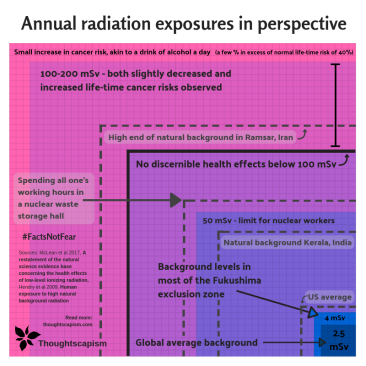
Radiation Exposures at a Glance – The entire square represents about 220 mSv/year, akin to a drink of alcohol a day.
Below 365 mSv/year may pose no likely harm for animals, but the stricter human health estimates set the no effects level at below 100 mSv/year, and consider possible small increase in life-time cancer risk on population levels at 200 mSv/year – akin to the risk from a drink of alcohol a day. More about radiation exposures and health effects in the infographic and the piece Radiation Exposures at a Glance.
This does not mean that most of the Exclusion Zone would be considered uninhabitable. In fact, soon after the evacuation, some 200 people decided to disobey the official orders and went back to live in their homes. They have lived there ever since, farming and gathering food in the Exclusion Zone. Their health has been monitored carefully, and despite ingesting foodstuffs grown in the zone, their health has been comparably better than their counterparts remaining in the city. The main concern for ingestion, Cesium-137, turns out not to have a great impact thanks to its long half-life (=low activity) and the fact that it does not accumulate anywhere in the body. In a UN University lecture on health impacts of nuclear accidents, radiation biology Professor Gerry Thomas reports that:
the people who went back to live in the Chernobyl Zone, over the period of 25 years, accumulated about a CT-scan’s worth of radiation.
In fact, most of the Exclusion Zone is less radioactive than other naturally high background-radiation areas like Kerala, India and Ramsar, Iran, which are inhabited, with no observed increase in the inhabitants’ life-time cancer risk.
So why was the Zone evacuated?
Here is where things get difficult. The evacuation has more to do with psychological than physical health effects. The authorities, which had first handled the situation poorly and tried to conceal the severity of the accident, later tried to regain the public’s trust by overcompensating with safety measures. As reported by the IEEE, tragically, the large-scale evacuation was not in the people’s best interest:
A second round of evacuations, in 1990-91, aggravated stress without materially protecting anybody from further irradiation.
The evacuation actually placed rural populations at more risk also from the ill health effects by exposure to urban air pollution – as laid out by the 2007 study Are passive smoking, air pollution and obesity a greater mortality risk than major radiation incidents? More recent research from University of Bristol comes to the same conclusion. With regards to the 116,000 people moved from the Zone initially, they say:
what if these evacuees had stayed in their homes? 85,000 would have lost, on average, 3 months’ life expectancy, just two thirds of the 4½ months the average Londoner loses to air pollution at the current time.

Environmental Progress‘ infographic on the 2007 study Are passive smoking, air pollution and obesity a greater mortality risk than major radiation incidents?
What comes to the larger evacuation four years down the line:
none of the extra 220,000 people relocated in 1990 should have been asked to move out. Overall, the J-value shows that 80% to 90% of the 335,000 people in total moved away from the Chernobyl area ought to have been allowed to stay in their homes.
(They also note that any long-term evacuation after Fukushima Daiichi accident, which is not expected to cause any deaths from radiation, is difficult to justify. For more: the WHO.)
Now, three decades later, studies on crop cultivation, and observations of animal life and human health effects of people living inside and outside the zone have reached the point that the local authorities have begun talking about opening parts of the zone up for human use once more. BBC Science Correspondent Victoria Gill reports from a meeting in Chernobyl (including a series of photos of the people living and working in the zone) in The end of three-decade experiment:
For the first time since the boundary was drawn, the zone is set to change. Three decades of research have concluded that much of it is safe – for food to be grown and for the land to be developed.
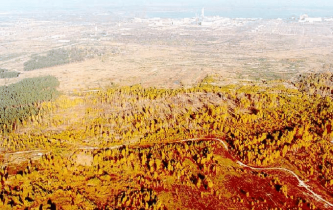
A few decades old photo of the Red Forest with the power plant in the background (from a study), for a photo from 2012, see copyrighted work here.
The ‘uninhabitability’ of the vast majority of the Zone, then, is of a political and psychological nature. The only areas that could be argued to be deserving of the actual ‘wasteland’ title would be the 4-5 square km of the Red Forest, and the failed reactor building itself (although the other reactors continued running normally and producing electricity until 2000), perhaps along with a few smaller hotspots.
As stated before, the first years saw a decrease in invertebrates, rodents, and a 5-7 year hiatus in seeding in areas within 40 square km (15 square miles). Notably most of those areas have recovered, and the heavily impacted areas now remain closer to 10 square km (4 square miles). Even those are frequented by many kinds of wildlife.
How do these impacts compare to effects of other energy accidents? This brings us to the next piece: World’s Worst Energy Accidents in Environmental Perspective.

More of my articles on: climate and energy. If you would like to have a discussion in the comments below, please take note of my Commenting policy. Note: if you make long-winded comments with strong claims, especially without clear and well sourced arguments, they may get buried in the back-log of comments waiting for approval, because my time to go through them is limited. Commenting policy in a nutshell:
- Be respectful.
- Back up your claims with evidence.



Dear Iida
Great post. It is also clearly a new post (no comments so far). I think you need to fix the dateline, which is April 14. Meredith Angwin
Not all those who wander are lost
>
LikeLike
Thanks Meredith!
How strange for the date to be stuck on April – it must have been when I first begun the draft. Thanks for pointing it out, corrected.
LikeLike
I appreciate that there’s a balanced view, but I wonder about the life spans of creatures in the zone. Sure the animals survive to breed and continue, but has any study been made of length of life and types of death of these animals?
LikeLike
Hello David,
I’m happy to hear you appreciate my overview. Concerning your question, as evidenced by the research I linked in the piece, there’s no conclusive evidence to point in the direction of much health effects. This is consistent with research suggesting below 365 mSv/year does not really harm terrestial animals, and plants and aquatic animals are even less sensitive.
Even with human populations, seeing an effect at a few hundred mSv/year levels, you need to study a population of millions to be able to see a few percent rise in life-time cancer risk. Most wild animals don’t make it into such a great old age for natural reasons.
I’ve written on what we know about radiation and cancer risk in more detail here: https://thoughtscapism.com/2018/03/01/radiation-and-cancer-risk-what-do-we-know/
Thanks for your interest.
Iida/Thoughtscapism
LikeLike
Thanks so much for this actual information!
LikeLiked by 1 person
Excellent piece. Thanks for writing this.
LikeLiked by 1 person
Thanks.
LikeLiked by 1 person
Hi Thoughtscapism (Ms/Mr)!!!
>
> I am utterly flabbergasted that I have not come across your incredible Blog until now!
> I (occasionally) write on the same subjects from the same point of view, but with considerably less regularity, fluency and research. When people ask me for articles or sources, I am often reduced to sending some of my own feeble efforts — or those of others. If I had known about YOUR treasure trove of resources I am sure that Science & Rationality would have many more converts!
> Well, better late than never — to coin a cliché.
> I am in a ridiculous rush at the moment, but as soon as I get the chance I will email a proper introduction.
> In the meantime, here are a few of my own skimpy efforts. Keep up the GREAT work, and I look forward to a mutually comradely correspondence! (Why the bleedin’ Hell I used “comradely” is a bottomless mystery!!!)
> All the best,
> Rob Johnston, MD
>
> 1) The great organic myths: Why organic foods are an indulgence the world can’t afford | The Independent
>
> https://www.independent.co.uk/environment/green-living/the-great-organic-myths-why-organic-foods-are-an-indulgence-the-world-cant-afford-818585.html
>
> 2) Vote green — go blackshirt | Samizdata Mobile
>
> https://www.samizdata.net/2008/02/vote-green-go-b/
>
> 3) Ten myths about nuclear power | Spiked online
>
> https://www.spiked-online.com/2008/01/09/ten-myths-about-nuclear-power/#.XNPrqmT4sR8.link
LikeLike
Dear Rob Johnston,
Thank you so much for such a heartily encouraging comment. I’m thrilled you appreciate my pieces, and would certainly welcome some mutually comradely correspondence. 🙂 If you would like to email me, leaving feedback in the fields in the About Me section, https://thoughtscapism.com/about/about-me/ sends an email to me and allows me to reply to you in kind, if you provide your address there. (Better option than posting emails in public.)
I’m happy to learn of your writing in a variety of publications on topics of science and skepticism.
Thanks for reading, and for your kind words!
All the best,
Iida/Thoughtscapism
LikeLike
Pingback: “What About Chernobyl?” World’s Deadliest Energy Accidents in Perspective | Thoughtscapism
Thank you for your article. After all the propaganda about this incident being portrayed by multiple media outlets, it is refreshing to see that the lies can be answered and corrected with facts. Now, If only we could convince our “leaders” not to bury their heads in green based hysteria!!!
LikeLike
Pingback: Visiting Chernobyl, Day One, The Most Dangerous Part of the Trip: Kyiv | Thoughtscapism
Pingback: The Animals of Chernobyl – Trip Report, Day Three | Thoughtscapism
Pingback: The Town That Remained Despite the Chernobyl Accident | Thoughtscapism